Georgia has the largest land area of any state of the United States east of the Mississippi River. Its large size and thriving industries have given it one of its nicknames, the Empire State of the South. Atlanta is Georgia’s capital and largest city. It is also the state’s chief industrial and transportation center.


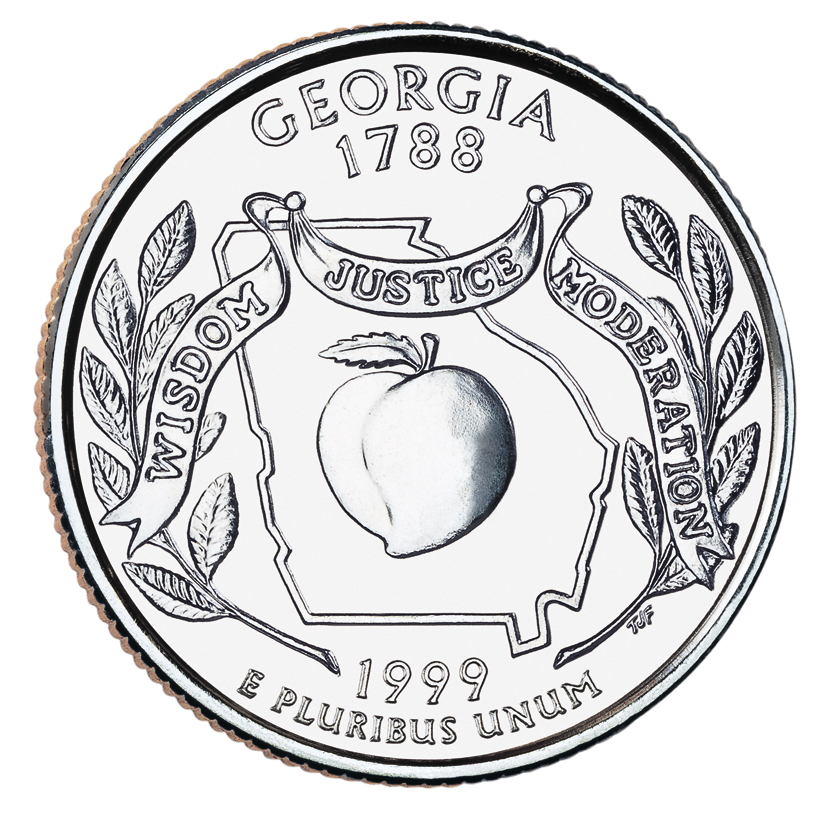
Large cotton plantations developed along the Georgia coast in the 1700’s, and raising cotton was the basis of the economy during most of the 1800’s. During the early 1900’s, many Georgia farmers began growing more of such crops as corn, fruits, and tobacco. Manufacturing expanded, and the weaving of cotton soon became more important than growing it. Today, service industries are Georgia’s chief source of income. Manufacturing is also an important source of income. Georgia’s leading manufactured goods include chemicals, food products, textiles, and transportation equipment.
But farming is still important to Georgia. The state is a leading producer of pecans and tobacco. It also ranks high in growing peaches and is sometimes called the Peach State. No other state produces more peanuts—often called goobers in the South—and Georgia is also known as the Goober State.
Mountains and ridges along Georgia’s northern border slope southward to a wide belt of gently rolling hills. Flat coastal plains, extending to the Atlantic Ocean, form the southern half of the state. Pine and hardwood forests cover large parts of Georgia. The state is one of the nation’s leading producers of forest products. The towering pine trees led to the expression “tall as a Georgia pine.” From beneath the land have come some of the largest blocks of marble, including two weighing about 90 tons (82 metric tons) each. Georgia marble was used in building the Lincoln Memorial in Washington, D.C., and the capitols of several states.
Much of Georgia is a mild, sunny land of pines, magnolias and moss-draped trees. The state’s natural beauty has inspired many songs and stories. The Suwannee River, which rises near Waycross, was made famous by Stephen Foster’s song, “Old Folks at Home.” Tales from Georgia include the Uncle Remus stories of Joel Chandler Harris. Other noted writers from Georgia include the poet Sidney Lanier and novelists Erskine Caldwell, Margaret Mitchell, Carson McCullers, Flannery O’Connor, and Alice Walker.
Georgia was the last of the 13 colonies in America to be founded. James Oglethorpe and the first band of English settlers arrived in 1733. The colony was named for King George II of England.
The University of Georgia became the first state-chartered university in the United States in 1785. In 1922, Rebecca L. Felton of Georgia became the first woman to serve in the United States Senate. In 1943, Georgia became the first state to allow 18-year-olds to vote.
Former Georgia Governor Jimmy Carter was elected the 39th president of the United States in 1976. Carter received the Nobel Peace Prize in 2002.
People
Population.
The 2020 United States census reported that Georgia had 10,711,908 people. The state’s population had increased about 11 percent over the 2010 census figure of 9,687,653. According to the 2020 census, Georgia ranks 8th in population among the 50 states.
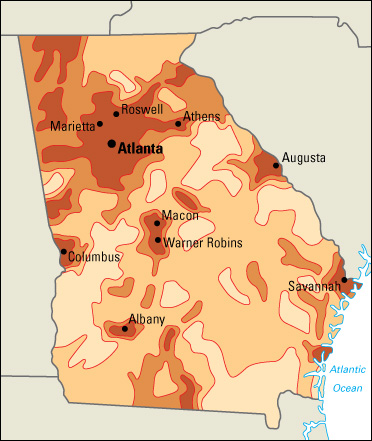

About 85 percent of Georgia’s people live in metropolitan areas. About half of all Georgians live in the metropolitan area of Atlanta, Georgia’s largest city. The state has 15 metropolitan areas (see Metropolitan area).
Georgia has six cities with populations of more than 125,000. The cities are, in order of size, Atlanta, Columbus, Augusta, Macon, Savannah, and Athens.
About 50 percent of Georgia’s residents are non-Hispanic white people. Large population groups include people of English, German, and Irish descent. About 30 percent of Georgia’s people are African Americans. Hispanics account for about 10 percent.
Schools.
During Georgia’s early days, most of the school buildings were cabins built by local farmers. These old field schools stood in a field provided by one of the farmers. Traveling schoolteachers, who were hired by the parents, ran the old field schools. Rich Georgia planters hired private teachers, most of them from New England, to teach their children. Sometimes children who lived at nearby plantations attended these plantation schools.
The state began paying teachers’ fees for some needy children during the early 1800’s, and built some public schools. But the schools received little or no state support after they had opened, and they had to charge tuition. At some manual-labor schools, students could pay part of their expenses by working on the schools’ farms. A few of Georgia’s cities and counties provided public funds for education, but most schooling was private.
In 1870, Georgia legislators created the state’s first public school system. They closely followed the recommendations of Gustavus Orr, who became the state commissioner of schools in 1872. Orr is known as the father of Georgia’s public school system.
Georgia has more than 180 public school districts. The state superintendent of schools, elected to a four-year term, directs the school program. The superintendent is the executive officer of the State Board of Education, the policymaking agency. Georgia law requires children between the ages of 6 and 16 to attend school. For the number of students and teachers in Georgia, see Education (table: U.S. students, teachers, and school expenditures).
The University of Georgia, which was incorporated in 1785, was the first state-supported university in the United States to receive a charter. The university graduated its first class in 1804. The university operated as a number of separately administered schools and colleges until 1931. That year, the state legislature joined these institutions under the governance of a Board of Regents. Georgia also has many technical colleges and a variety of continuing education programs.
Libraries.
The leaders of the Georgia colony established a library in Savannah in 1736. In 1888, Francis T. Willis, a physician of Richmond, Virginia, gave Georgia its first free library, the Mary Willis Library in Washington. The Young Men’s Library Association established one of the first libraries in Atlanta in 1867. This library was opened to the public in 1902, and today is the Atlanta-Fulton Public Library System, the largest public library system in Georgia.
Museums.
The museum at Ocmulgee Mounds National Historical Park, near Macon, is one of the largest museums of Indigenous (native) American history in the United States. It has exhibits that explain nearby Indigenous burial grounds. The Fernbank Museum of Natural History, in Atlanta, is one of the largest museums of natural history in the Southeast.
The High Museum of Art, in Atlanta, is one of the largest art museums in the United States. Other art museums include the Telfair Museums in Savannah, the Georgia Museum of Art at the University of Georgia in Athens, and the Michael C. Carlos Museum of Emory University in Atlanta.
Visitor’s guide
The natural beauty and famous resorts of Georgia attract visitors from all parts of the United States. Vacationers enjoy the water sports and luxury hotels of Sea Island and the other Golden Isles along Georgia’s coast. People fish for bass, flounder, mullet, and trout at the seashore or in Georgia’s many lakes and streams. Hunters trail deer, fox, and quail in the thick forests.
Since prehistoric days, people with physical disabilities have found relief in the soothing waters of Warm Springs. President Franklin D. Roosevelt, whose legs were paralyzed by polio, established a summer home there called the Little White House. Tourists can visit Roosevelt’s home.
Many beautiful monuments and parks—including reminders of important Civil War battles and heroes—dot the Georgia landscape. Stone Mountain, near Atlanta, has huge figures of Confederate leaders carved on its face (see Stone Mountain).
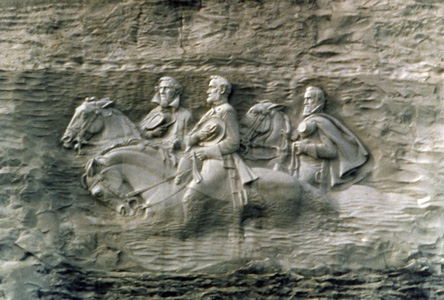
The most famous annual event in Georgia is probably the Masters golf tournament. It is held the second week in April at the Augusta National Golf Club. Top golfers from the United States and other countries compete in this tournament.
Land and climate
Land regions.
Georgia has six main land regions. The three northernmost regions form part of the Appalachian Mountains. They are (1) the Appalachian Plateau, (2) the Appalachian Ridge and Valley Region, and (3) the Blue Ridge. See Appalachian Mountains.
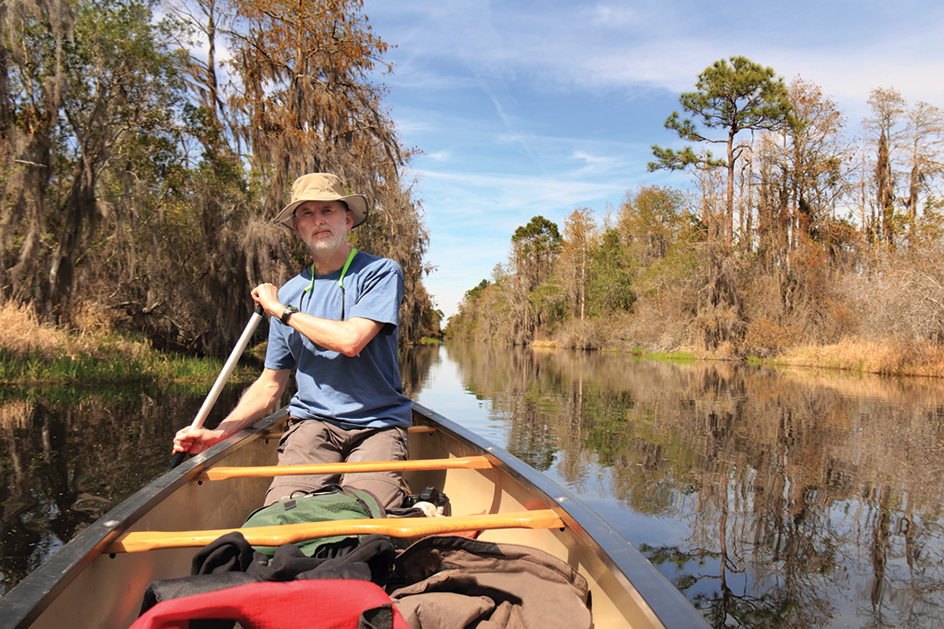


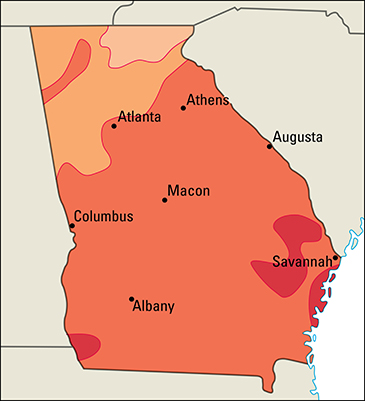
The other three land regions of Georgia are (4) the Piedmont, (5) the Atlantic Coastal Plain, and (6) the East Gulf Coastal Plain. The Piedmont is a wide belt of hilly and rolling land that lies along the eastern edge of the central and southern Appalachians. It reaches across most of the northern half of Georgia, just south of the Appalachian areas (see Piedmont Region). Georgia’s two coastal plains form part of the great lowland that lies along the Atlantic Ocean and Gulf of Mexico from Massachusetts to Central America.
The Appalachian Plateau
covers the northwestern corner of Georgia. It ranges from 1,800 to 2,000 feet (550 to 610 meters) above sea level. Narrow valleys separate wooded ridges on the plateau. Thin, sandy soil makes this region the state’s poorest farming area.
The Appalachian Ridge and Valley Region,
also in northwestern Georgia, has several broad, fertile valleys separated by long, parallel ridges of sandstone rocks. Pine and hardwood forests once covered these valleys. Today, the rich soils produce fruits, grains, and vegetables, though much of the area is still forested. Beef cattle graze in the valley pastures.
The Blue Ridge
rises in the northeastern part of the state. The peaks vary from 2,000 to nearly 5,000 feet (610 to nearly 1,500 meters) above sea level. Hardwoods and pine trees cover the slopes of these mountains. The region’s rivers provide much of the state’s hydroelectric power.
The Piedmont
has gently rolling hills. The northern edge of the region meets the Appalachian areas at about 1,500 feet (457 meters) above sea level. The Piedmont gradually slopes down toward the south, where it meets the coastal plains at an elevation of less than 400 feet (120 meters). Such large cities as Atlanta and Athens help make the region the most heavily populated section of Georgia. Three other large cities, Augusta, Columbus, and Macon, lie at the southern boundary of the Piedmont, which is known as the Fall Line (see Fall line). These cities grew at water power sites, where rivers flow from the Piedmont to the softer ground of the coastal plains and form falls and rapids.
The Atlantic Coastal Plain
spreads across more than a fourth of the state in the southeast. This flatland has a light, sandy loam soil that is good for growing onions, peanuts, sweet potatoes, tobacco, and watermelons. The rivers follow the slope of the plains and flow into the Atlantic Ocean. Okefenokee Swamp lies in the southern part of the Atlantic Coastal Plain and extends into the East Gulf Coastal Plain.
The East Gulf Coastal Plain
covers almost a fourth of Georgia in the southwest. Its flat surface resembles that of the Atlantic Coastal Plain, but it has much richer soils and more land in crops. Soybeans, peanuts, and tobacco are its leading crops. The rivers draining the region flow to the Gulf of Mexico.
Coastline.
Georgia has 100 miles (161 kilometers) of general coastline on the Atlantic Ocean. If bays, offshore islands, and river mouths are included, the coastline measures 2,344 miles (3,772 kilometers). The principal ports are Savannah and Brunswick. Several islands along the coast are popular vacation resorts.
Mountains.
The Appalachian Mountains in Georgia cover about 1,850 square miles (4,971 square kilometers). The Blue Ridge is the main range of these mountains. Travelers can easily cross the Blue Ridge at Rabun Gap in the northeastern corner of the state and at Ellijay Valley in north-central Georgia. A steep climb is necessary to cross the range at other places. More than 20 Georgia mountains rise more than 4,000 feet (1,200 meters) above sea level. The state’s highest peak is 4,784-foot (1,458-meter) Brasstown Bald Mountain, also called Mount Enotah, near Young Harris.
Rivers, lakes, and waterfalls.
Georgia has several large rivers that flow from the higher elevations in the north down toward the Gulf of Mexico or the Atlantic Ocean. These rivers include the Altamaha, Chattahoochee, Flint, and Savannah. Some streams of northwestern Georgia empty into the Tennessee River.
Hydroelectric power dams form beautiful lakes on many rivers. These lakes include Allatoona Lake on the Etowah River, Hartwell and J. Strom Thurmond lakes on the Savannah, Lake Sidney Lanier on the Chattahoochee, Lake Seminole on the Flint and Chattahoochee, and Lake Sinclair and Lake Oconee on the Oconee.
The most beautiful waterfalls in the state are Amicalola and Toccoa. Amicalola Falls on Amicalola Creek plunges 729 feet (222 meters) near Dawsonville. Toccoa Falls, formed by Toccoa Creek near Toccoa, drops 186 feet (57 meters).
Plant and animal life.
Forests cover about 65 percent of Georgia. Pine and hardwood trees cover northern Georgia. The southern half of the state has chiefly pines and live oaks. Laurels and rhododendrons grow in the mountains. Beneath the tall trees of the coastal area is a thick undergrowth of grass, small shrubs, palmettos, and vines. Wildflowers add their beauty throughout the state. They include Cherokee roses, daisies, Japanese honeysuckles, and violets.
Animal life in Georgia includes bears, beavers, deer, foxes, opossums, rabbits, raccoons, and squirrels. The state has such game birds as doves, marsh hens, quail, ruffed grouse, wild turkeys, and many kinds of ducks. Such songbirds as brown thrashers, mockingbirds, and wood thrushes add their melodies to Georgia’s landscape. One of the largest natural bird refuges in the country is Okefenokee Swamp, which covers 700 square miles (1,813 square kilometers) in southeastern Georgia. The state’s inland waters are the home of bass, bream, catfish, eels, rainbow trout, and shad. Alligators, crabs, oysters, turtles, and shrimp are plentiful in the coastal waters.
Climate.
Georgia has a mild climate, with an average annual temperature of 64 °F (18 °C). Most of the state has warm, humid summers and short, mild winters. The mountainous north has cool summers and fairly cold winters.
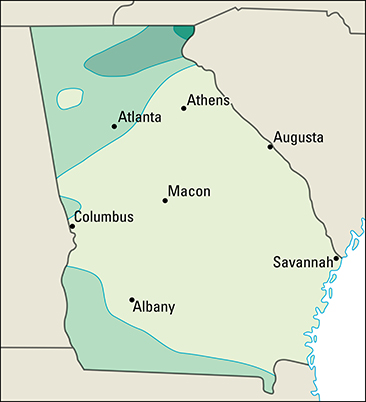
January temperatures average 51 °F (11 °C) in the south and 41 °F (5 °C) in the north. In July, southern temperatures average 82 °F (28 °C), while temperatures in the north average 78 °F (26 °C). The state’s highest recorded temperature, 112 °F (44 °C), occurred at Louisville on July 24, 1952, and at Greenville on Aug. 20, 1983. The lowest, –17 °F (–27 °C), occurred in Floyd County on Jan. 27, 1940.
Georgia’s precipitation (rain, melted snow, and other forms of moisture) averages 50 inches (127 centimeters) a year. Northern Georgia is the rainiest part of the state. About 1 inch (2.5 centimeters) of snow falls yearly.
Economy
Georgia’s economy has kept pace with its rapidly growing population. Service industries, taken together, make up the largest part of Georgia’s gross domestic product—the total value of all goods and services produced in the state in a year.
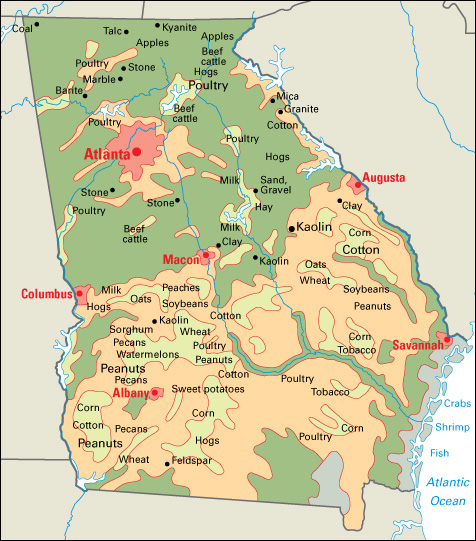
Atlanta is one of the nation’s centers of finance, trade, and transportation. Such major companies as Coca-Cola, Delta Air Lines, Georgia-Pacific, Home Depot, and United Parcel Service are headquartered in the city. Outside of the Atlanta area, important economic activities include paper and textile manufacturing, chicken and peanut farming, and clay mining.
Natural resources
of Georgia include various mined products, abundant forests, and plentiful water supplies.
Soils.
Fertile soils occur in the valleys of mountainous northern Georgia, especially in the Appalachian Ridge and Valley Region. Ridges in this region have coarse, sandy soil, with low fertility. Thin, sandy soils cover the Appalachian Plateau. Clay loams with red clay subsoils cover the Piedmont and give many of the hillsides a red color. The soils of the coastal plains are reddish-brown, sandy loams of medium fertility.
Minerals.
Clays are the state’s most important mined product. Clays and large deposits of granite lie along the southern edge of the Piedmont. The chief marble deposits are in Pickens County. The Piedmont also has rich deposits of feldspar and granite, and some gold. Most of the gold in the United States once came from northern Georgia, where the nation’s first major gold rush took place in the late 1820’s. The gold mining ended in 1849, after larger deposits were discovered in California.
Mined resources of the coastal plains include claylike materials called fuller’s earth, used mainly as a cleaner and purifier; kaolin, used in ceramics; and bentonites, used in oil drilling. Deposits of barite and manganese occur near Cartersville. The state’s coal deposits are in the Appalachian Plateau. Other mined products include limestone, mica, and sand and gravel.
Forests
cover about two-thirds of Georgia. The state has many kinds of trees, including cedars, hickories, oaks, pines, sweet gums, tupelos, walnuts, and yellow-poplars. Pine and hardwood trees cover the northern half of the state. The southern half has chiefly pine trees and magnificent live oaks, the state tree. Beech, birch, hickory, maple, and oak trees cover parts of the Blue Ridge.
Service industries
account for over 80 percent of Georgia’s gross domestic product and employment. Atlanta, the state capital, is the center of government activities. The city is also the headquarters of the Sixth Federal Reserve District Bank, one of the 12 federal banks established by Congress. Many of the state’s hotels, restaurants, and retail trade establishments are also in the Atlanta area.
Some of the nation’s largest transportation and communication companies are based in Atlanta. The city is the home of Delta Air Lines, Inc., a major airline. In addition, Turner Broadcasting System, Inc., and Cable News Network were established in Atlanta by business executive Ted Turner in the late 1970’s and early 1980’s. They strengthened the city’s position as a major communications center. AT&T Inc. maintained a major operation in Atlanta after acquiring the communications company BellSouth in 2006.
Atlanta, Columbus, and Macon have large insurance companies. Georgia’s military bases include the U.S. Army Signal Center near Augusta, a U.S. Navy submarine base, and several Army and Air Force bases.
Manufacturing.
Processed foods and beverages make up Georgia’s leading category of manufactured products. The major food products are baked goods, beer, packaged chicken, and peanut butter. Atlanta, Columbus, and Rome have large bakeries. Albany and Cartersville have breweries. Large plants throughout the state process chicken. Peanut products are made in Dawson and several other towns.

The Atlanta and Augusta areas are the chief centers of chemical production in Georgia. Military aircraft and missiles are manufactured in the Atlanta area. Brunswick and Jesup have pulp mills. Augusta, Macon, Rome, and several other towns have paperboard mills. Albany has a factory that makes bathroom tissue. Georgia is a leading state in the production of textiles and textile products. Dalton manufactures more carpeting than any other city in the nation. Calhoun, Chatsworth, and LaGrange also have large carpet mills.
Agriculture.
Farms cover about a fourth of Georgia’s land area. Georgia ranks among the leading states in producing broilers (young, tender chickens). Broilers are the state’s leading farm product. Eggs are also a leading product. Georgia’s broiler and egg production is heaviest in the northern third of the state.
Beef cattle, hogs, and milk are also important sources of farm income. Southwestern and northeastern Georgia are the leading areas for hog farming, and northeastern Georgia is the leading area for beef-cattle farming. Macon County is the leading dairy farming area.
Cotton is Georgia’s most valuable crop. It is grown primarily in the southwestern part of the state. Georgia ranks among the leading states in cotton production.
Peanuts rank as an important crop. Georgia leads the nation in peanut production. Farmers throughout the southwestern part of the state raise peanuts. Georgia is also a leading pecan-producing state. The Albany area is one of the nation’s centers for the production of paper-shell pecans.
Another of the state’s important field crops is tobacco, which is grown primarily in southern Georgia. Other crops include corn, hay, oats, rye, sorghum grain, soybeans, and wheat. Cucumbers, onions, sweet corn, and tomatoes are among Georgia’s most valuable vegetables. The raising of greenhouse and nursery products is an important agricultural activity in southern Georgia.
Georgia is a leading peach producer, and one of its nicknames is the Peach State. Other important fruit crops include blueberries, grapes, and watermelons.
Mining.
Clays are Georgia’s most valuable mined product, and the state leads the United States in clay production. Georgia is the leading producer of kaolin, a clay used to make pottery and in coating paper to give it a glossy finish. One of the nation’s greatest kaolin belts lies across Georgia, just south of Augusta and Columbus. Georgia is a leading producer of fuller’s earth.
Georgia ranks among the leading states in the production of granite. Sand and gravel production, also important in Georgia, is centered in the Piedmont. The state also mines barite, feldspar, limestone, and mica.
Fishing industry.
Shrimp are by far the most valuable type of catch for the state’s fishing industry. Clams, finfishes, and oysters are also important catches.
Electric power and utilities.
Southern Company, one of the nation’s largest utilities, is headquartered in Atlanta. Nuclear plants and power plants that burn coal and natural gas supply most of the electric power generated in Georgia. Renewable sources supply most of the rest of the electric power.
Transportation.
Hartsfield-Jackson Atlanta International Airport is Georgia’s busiest airport. It ranks among the world’s leading airports in aircraft take-offs and landings and in passenger arrivals and departures. Savannah has Georgia’s second busiest commercial airport.
Georgia began building state highways during the early 1900’s and paving county roads after World War II (1939-1945). Today, the state has an extensive system of roads and highways. Development of an extensive system of railroads began in Georgia before the American Civil War (1861-1865). Today, Atlanta is the chief railroad center of the Southeast.
Savannah handles more waterborne cargo than any other port in Georgia. The State Port of Savannah is one of the most modern United States ports. Brunswick is the state’s other major port. Barges can travel to Georgia ports via the Atlantic Intracoastal Waterway or along the state’s rivers. The Flint River is navigable to Bainbridge, and the Chattahoochee River to Columbus.
Communication.
The state’s first newspaper, the Georgia Gazette, was founded in Savannah in 1763. The Cherokee Phoenix, the first-known newspaper in the United States to be published using an Indigenous American language, was established in New Echota in 1828. It was printed in English and in the Cherokee writing system invented by Sequoyah, a Cherokee (see Sequoyah). The Augusta Chronicle, Georgia’s oldest newspaper still being published, first appeared in 1785.
Numerous newspapers are published in the state today. The Atlanta Journal-Constitution, The Augusta Chronicle, The Telegraph of Macon, and the Savannah Morning News are among the largest.
Government
Constitution
of Georgia was adopted in 1982 and went into effect in 1983. Earlier constitutions had been adopted in 1777, 1789, 1798, 1861, 1865, 1868, 1877, 1945, and 1976. An amendment (change) to the Constitution can be proposed by the legislature or by a constitutional convention called by the legislature. An amendment must be approved by a majority of the people voting on it in a general election.
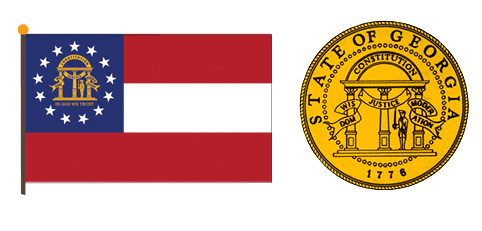
Executive.
The governor of Georgia is elected to a four-year term. A person can serve only two consecutive terms as governor. The governor is the director of the budget and has great control of state finances. The governor also appoints hundreds of state officers and members of boards and commissions, in most cases with the approval of the state Senate.
Other elected state officials include the lieutenant governor, attorney general, commissioner of agriculture, commissioner of labor, insurance commissioner, secretary of state, and superintendent of schools. All serve four-year terms. The voters also elect the five members of the Georgia Public Service Commission to six-year terms. The commissioners control the rates and services of transportation companies and of public utilities, such as electric and telephone companies.
Legislature
of Georgia is called the General Assembly. It consists of a Senate of 56 members and a House of Representatives of 180 members, all elected to two-year terms. Annual legislative sessions begin on the second Monday in January and last 40 working days.
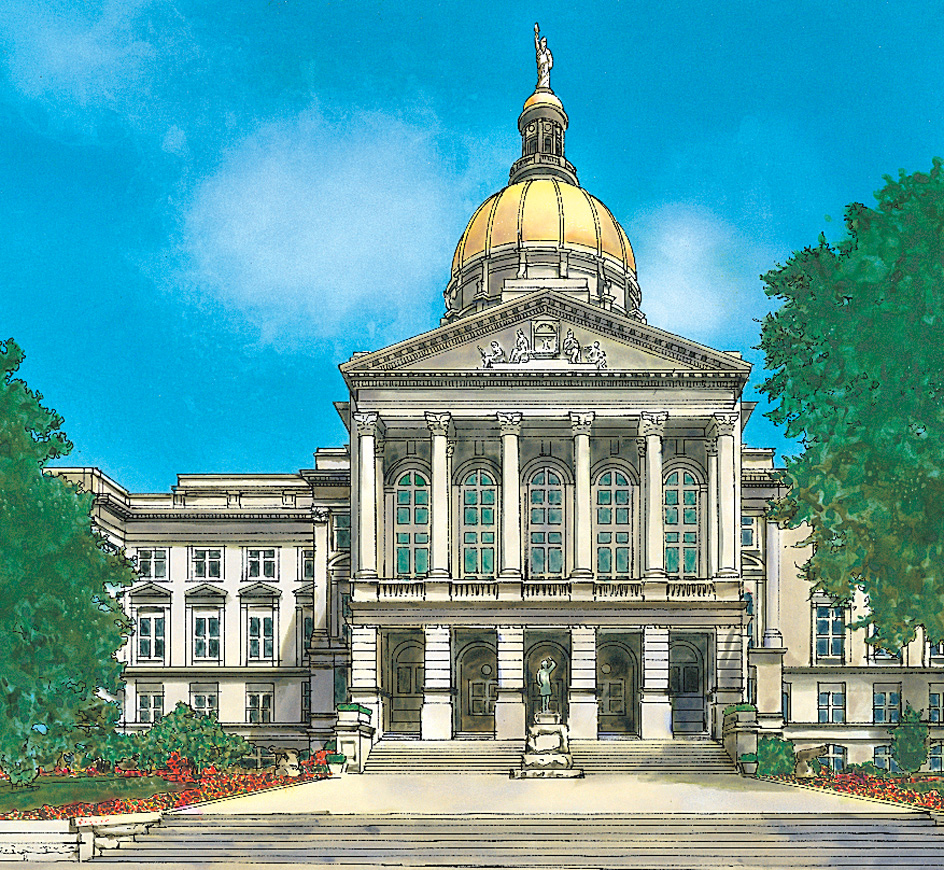
Courts.
The highest court in the state is the Supreme Court of Georgia. It has a chief justice and eight associate justices, elected to six-year terms. The justices choose one of their number to be chief justice. The Supreme Court is the state’s highest appeals court. There is also a lower 15-judge Court of Appeals. The judges of this court are elected to six-year terms. The chief trial courts in Georgia are the superior courts, which are organized into 49 judicial circuits. Each judicial circuit consists of one or more counties. Judges of the superior courts are elected to four-year terms. Below the superior courts are state courts, juvenile courts, probate courts, magistrate courts, and municipal courts.
Local government.
More than 150 of Georgia’s 159 counties are governed by boards of commissioners. These boards have from 3 to 10 members, depending on special acts of the legislature. Georgia’s other counties are governed by one commissioner instead of a board. All commissioners are elected. Most of them serve four-year terms. Many counties also have a county manager or administrator. Muscogee County has a joint council-manager government with the city of Columbus, as does Clarke County with Athens and Richmond County with Augusta.
Georgia has hundreds of cities, towns, and villages. Their charters are drawn up and amended by special acts of the legislature. However, in 1965, the legislature passed a home-rule law giving local governments the power to deal with many administrative and service matters without needing amendments to their charters. No charter or amendment may conflict with state laws. Most of Georgia’s cities have mayor-council governments. Many have city managers.
Revenue.
Taxation provides about half of the state government’s general revenue (income). Most of the rest comes from federal grants and other U.S. government programs. A personal income tax and a general sales tax are the main sources of tax money. Other taxes include those on corporate income, motor vehicle licenses, and on sales of alcohol, gasoline, and tobacco.
Politics.
The Democratic Party controlled Georgia politics throughout most of the state’s history. For example, from 1872, during the Reconstruction period, to 2003, all the state’s governors were Democrats. In 1964, Georgia elected its first Republican U.S. representative since 1872. Also in 1964, Barry M. Goldwater of Arizona became the first Republican presidential candidate ever to win the electoral votes of Georgia. George C. Wallace of the American Independent Party carried Georgia in 1968. Since then, the Republican presidential candidate has won the state’s electoral votes more often than the Democratic candidate.
Republican strength in the state has increased since the 1960’s. By the early 2000’s, Republicans controlled the General Assembly and held majorities among Georgians in the U.S. Congress. Republican gains were partially offset because of the strong support of African Americans for the Democratic Party. Democratic support is strongest near Atlanta, Athens, and Augusta, and in the African American majority counties sometimes known as the Black Belt. Republicans have support throughout the state.
Until 1962, Democratic candidates for state offices and the U.S. House of Representatives and Senate were nominated under the county-unit system. The nominations went to those candidates who won primary elections in the most counties, regardless of the total number of popular votes. In 1962, a United States district court ruled the county-unit system unconstitutional. Later that year, primary election results were determined by popular vote for the first time. As a result, voters in heavily populated counties gained much greater power to nominate candidates.
History
Early days.
Archaeological evidence suggests that human beings have inhabited what is now Georgia for more than 10,000 years. About 4,500 years ago, Indigenous people in the Savannah River basin began making pottery, and they traded across the Southeast. By about 1,100 years ago, the people of the area were growing corn and beans. They built a number of towns and large earthen mounds. See Mound Builders.
Spanish control.
In 1540, Hernando de Soto of Spain led an expedition through Georgia on his way from Florida to the Mississippi River. He and his army came upon several mound builder towns and treated Indigenous people cruelly. De Soto soon moved on in search of riches. But many Indigenous people died from the diseases the Europeans had brought.
In 1565, Spain sent forces to destroy French settlements along the Atlantic coast. The Spanish soldiers built a fort at St. Augustine in what is now Florida and defeated the French. In 1566, the Spanish commander, Pedro Menéndez de Avilés, met with the the Indigenous Guale people on St. Catherines Island and won permission to construct a fort. The Spaniards also built several missions along the Georgia coast. By the early 1600’s, Spanish missionaries had baptized thousands of Indigenous people, and the missions supplied the settlement at St. Augustine with food and laborers.
English colony.
Around the 1600’s, some remnants of the mound-building peoples joined together into a confederacy dominated by the Muscogee (also spelled Muskogee). English colonists later called this group the Creek Confederacy.
In the late 1600’s, attacks by Indigenous warriors and by pirates sponsored by the English destroyed the Spanish mission system along Georgia’s coast. In the early 1700’s, the English gained control of the Georgia coast by defeating Spain and its Indigenous allies during Queen Anne’s War (1702-1713). The war was one of the four conflicts that made up the French and Indian wars (1689-1763).
In 1730, a group of wealthy Englishmen, led by John Percival and James Oglethorpe, requested a charter from King George II to form a charitable colony. The colony, to be controlled by trustees, would provide farms and a new start for poor but deserving Englishmen and persecuted Protestant Christians from Europe. In 1732, King George II granted a 21-year charter for the colony of Georgia, which was named for him.

Oglethorpe and about 120 colonists set sail on the ship Ann on Nov. 17, 1732. They arrived at Yamacraw Bluff on the Savannah River on Feb. 12, 1733. A small town of Indigenous people led by Tomochichi welcomed the settlers, who began to build what would become Savannah. Over the next 20 years, more than 5,000 Europeans settled in Georgia. About half of them came on the trustees’ charity. The colony tried to promote economic equality by allowing no one to own more than 500 acres (200 hectares) of land and by prohibiting slavery.
In 1739, war broke out again between Britain and Spain. In North America, several battles took place in southern Georgia and Florida. The Spaniards attempted to invade Georgia in 1742, but the colonists defeated them at the Battle of Bloody Marsh on St. Simons Island. The British maintained control of the Georgia coast.
At this time, however, the Georgia colony began to fail. Many of the colonists did not share the idealism of the trustees. They resented the limits on land ownership and the prohibition of slavery. They believed that Georgia needed large plantations farmed by enslaved people to prosper. The discouraged trustees surrendered their charter in 1752. Georgia became a royal colony, headed by a governor that the British king appointed.
Under royal government, large plantations grew up along the Georgia coast, and thousands of enslaved people were imported to work on them. The royal governor also negotiated successfully with the Muscogee (Creek) and Cherokee peoples for land and greatly increased the size of the Georgia colony. But some wealthy planters along the coast began to resent British authority and wanted more political control over their own affairs. Settlers who lived upcountry (inland) wanted more land and a more aggressive policy against Indigenous groups.
The Revolutionary War.
The first battles of the American Revolution took place in April 1775 in Massachusetts. By the summer of 1775, the Georgia coastal planters and the upcountry settlers working together challenged British authority in Georgia. In February 1776, the royal governor fled to a British warship off the coast. The Georgia revolutionaries organized a government and prepared for war.
Fighting occurred in March 1776 when British naval forces tried to steal rice boats from Savannah’s harbor. Several of the boats were destroyed by fire. On July 24, 1778, Georgia ratified (approved) the Articles of Confederation, the forerunner of the United States Constitution. In December 1778, British troops launched a surprise attack and captured Savannah. In September 1779, American and French forces working together tried to recapture the city but were defeated. Raids and fighting continued in Georgia until the British evacuated Savannah in the summer of 1782.
Early statehood.
The Revolutionary War ended in 1783. On Jan. 2, 1788, Georgia became the fourth state in the Union to ratify the United States Constitution.
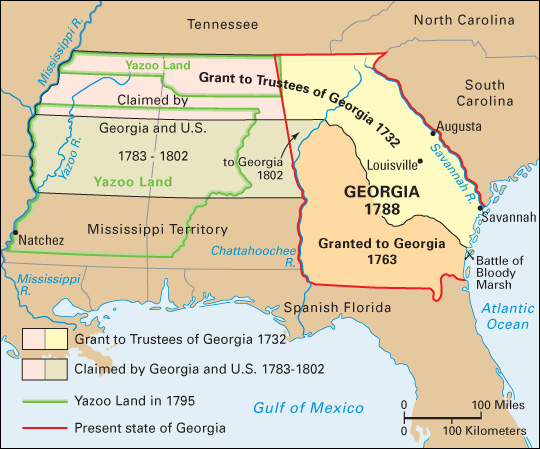
Eli Whitney invented the toothed cotton gin near Savannah in 1793. This machine, which separated the seed from the fiber, saved much work and led to a great expansion in cotton farming.
Settlers and land companies began developing Georgia rapidly during the 1790’s. In 1795, land companies bribed state legislators to sell them Georgia land, which they planned to sell at great profit. This scheme came to be known as the Yazoo Fraud, because the Yazoo River flowed through part of the land. Angry Georgians elected a new legislature that repealed the sale in 1796. But many buyers refused to give up their purchases. In 1802, Georgia sold its lands west of the Chattahoochee River to the federal government, and the government later settled the Yazoo claims. See Yazoo Fraud.
By 1827, the Muscogee had sold all their land in Georgia to the United States and moved to the Arkansas Territory. In 1838, federal troops rounded up the last of the Cherokee in Georgia and forced them to move to the Indian Territory in present-day Oklahoma. As Indigenous people left, settlers quickly cleared the land and planted cotton. By 1840, Georgia had begun developing an extensive railway system.
The Civil War.
In the mid-1800’s, Georgia’s economy was based on raising cotton, and many Georgians depended on the labor of enslaved people. Many of Georgia’s leaders feared that Abraham Lincoln, the Republican presidential candidate in 1860, would work to end slavery. They also resented the growing economic and political power of the North. After Lincoln was elected, Governor Joseph E. Brown led the movement for Georgia’s secession (withdrawal) from the Union. Opposition to the movement was led by Alexander H. Stephens, a former congressman. Stephens later became vice president of the Confederacy. On Jan. 19, 1861, Georgia became the fifth Southern state to secede.
Early in the Civil War (1861-1865), the Union Navy raided the Georgia coast and closed the port of Savannah. Confederate troops won the first great battle in Georgia—at Chickamauga in September 1863. The following May, General William T. Sherman’s Union forces advanced on Atlanta from Chattanooga, Tennessee.
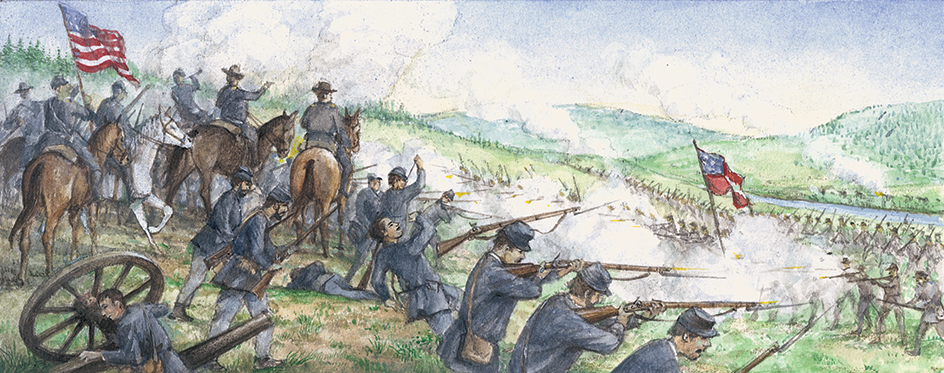
Sherman captured Atlanta in September. In November, he burned Atlanta and began his famous march to the sea. As Sherman’s troops marched almost unopposed across Georgia to Savannah, they cut a path 60 miles (97 kilometers) wide, destroying all factories, mills, public buildings, and railroads. The troops carried few supplies and lived off the land. They looted the countryside, stealing food and other property from the plantations and towns. Sherman captured Savannah in December 1864. See Civil War, American (The Atlanta campaign) (Sherman’s march through Georgia).
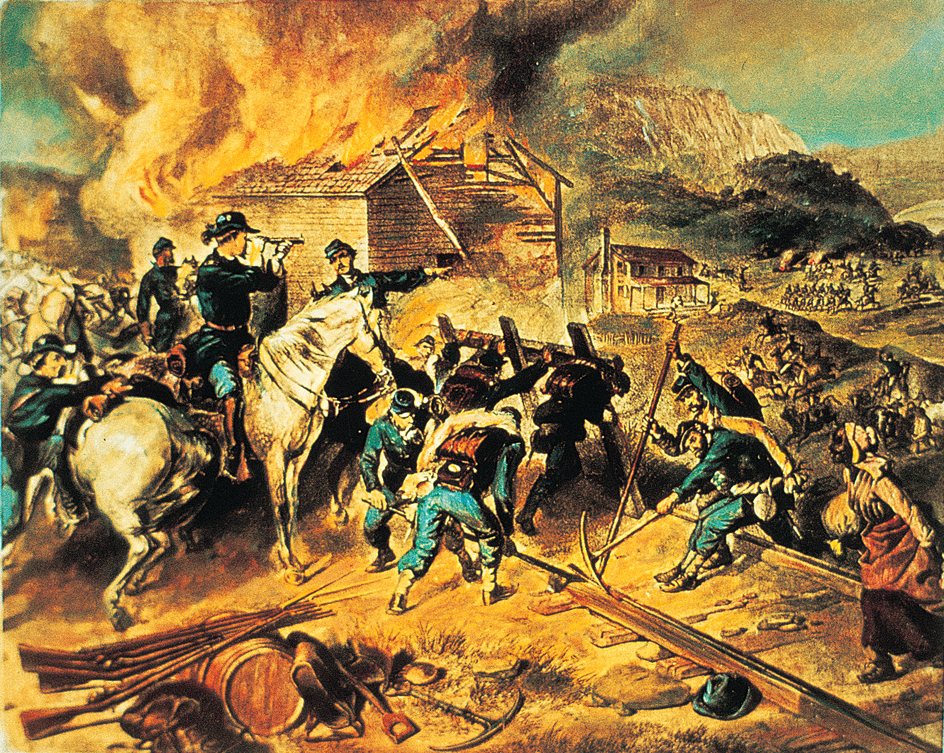
Slavery ended wherever Sherman’s forces took control. Thousands of enslaved people in Georgia ran away, and many of them joined the Union Army.
Reconstruction and recovery.
During the Reconstruction period that followed the Civil War, Georgia faced the challenges of rebuilding physically and politically and of coping with the social and economic changes that resulted from emancipation. People who had been enslaved sought new roles as citizens and workers. White conservatives fought to regain control over them, and the struggle sometimes became violent. The federal government established the Freedmen’s Bureau to help formerly enslaved people (see Freedmen’s Bureau) and set up military rule in Georgia that lasted off and on until 1870.
Georgia was readmitted to the Union in 1868. But it was expelled in 1869 because it refused to ratify Amendment 15 of the U.S. Constitution. This amendment made it illegal to deny the right to vote on the basis of race. Georgia ratified the amendment in 1870 and was permanently readmitted to the Union on July 15.
By the early 1870’s, however, white conservative Democrats gained political control, and they increasingly excluded Black Georgians from government and politics. Most of Georgia’s freed people continued to work producing cotton through tenant and sharecropping agreements. By 1880, cotton production had returned to its pre-war levels. It continued to increase as more farmlands became devoted to growing cotton.
Manufacturing and trade also began expanding in Georgia in the 1870’s. Railway construction resumed, banking activities increased, and cities grew.
The early 1900’s.
Industry continued to grow after 1900, and farmers began depending less on cotton. The production of corn, fruits, livestock, and tobacco gained in importance. After the United States entered World War I in 1917, Georgia’s factory and farm production expanded still further.
In 1922, Rebecca L. Felton became the first woman U.S. senator. She was appointed by Governor Thomas W. Hardwick after Senator Thomas E. Watson died. Felton served only one day while Congress was in session. Walter F. George, who had been elected to complete Watson’s term, took her place.
Beetles called boll weevils caused great damage to Georgia’s cotton crops during the early 1920’s. As a result, many farmers lost their crops and could not afford to keep their farms. In 1929, the Great Depression hit the state. Many factories had to close down. Federal programs began to create jobs in 1933. The programs included construction of highways, public buildings, and sewerage and drainage systems. Federal soil conservation programs helped many farmers.
The mid-1900’s.
Manufacturing activity in Georgia increased again during World War II (1939-1945). Many Georgians worked in various defense industries during the war. Large numbers of farm workers left rural areas to take defense jobs in cities, and many of them stayed in the cities after the war. In 1943, Georgia became the first state to allow 18-year-olds to vote.
After World War II, many companies from outside the state opened factories and offices in Georgia. Georgians continued to move into the cities to fill jobs created by the industrial expansion.
Julian Bond, an African American civil rights leader and a Democrat, won election to the Georgia House of Representatives in 1965. At first, the other Georgia House members refused to let Bond be seated. They said they objected to his statements opposing U.S. involvement in the Vietnam War (1957-1975). But in 1966, the Supreme Court of the United States ruled that the House had denied Bond his freedom of speech and must seat him.
Until the 1960’s, the Democratic Party controlled Georgia politics almost completely. Then, many Georgians became dissatisfied with some policies of the national Democratic Party, especially its support of civil rights legislation. The Republicans began gaining strength.
Like many other states, Georgia has had serious racial problems. In 1954, the Supreme Court of the United States ruled that compulsory segregation in public schools was unconstitutional. Early in 1960, Georgia had to integrate its public schools under federal court orders or close them. A special committee appointed by the state legislature held public hearings on the issue throughout the state. The legislature then passed laws prohibiting compulsory segregation.
In 1961, Black children attended all-white schools in Georgia for the first time. By the mid-1960’s, several school districts and colleges had been integrated. However, in August 1969, the U.S. Department of Justice filed a suit against Georgia calling for complete integration of the state’s public schools.
Integration also took place in other areas of Georgia life, including libraries and restaurants. Some white people in Georgia resisted the change. In 1964, for example, Lester G. Maddox closed his Atlanta restaurant rather than obey a federal court order to serve Black customers.
In 1966, Maddox, a Democrat, became a candidate for governor. None of the candidates received 50 percent of the votes, and Georgia law provided that the state legislature choose a winner. The legislature elected Maddox governor in January 1967. In November 1968, Georgia voters approved a constitutional amendment providing that elections that do not give any candidate at least half the votes be decided by a runoff election. The two candidates who received the most votes in the first election would oppose one another in the runoff.
The late 1900’s.
The growth of industry helped Georgia’s economy, but it also created problems. Sections of the cities became crowded and run-down. The increased industrial activity and population in the state caused air and water pollution. The population continued to shift from rural to urban areas. Cities and towns won long-sought powers in the mid-1970’s, when the state government authorized them to levy new local taxes. The state continued to seek ways to redevelop rural areas and, thereby, slow the shift of people to the cities.
Racial tension eased, though school integration remained a major concern in Atlanta and other Georgia cities. White families moved from heavily Black school districts in Atlanta, and Black residents outnumbered white residents in the city. In 1973, Maynard H. Jackson, Jr., was elected mayor of Atlanta. He became the first African American mayor of a large Southern city. Jackson won election three times, serving as mayor from 1974 to 1982 and from 1990 to 1994.
In 1976, former Georgia governor Jimmy Carter was Elected U.S. president. He held office from 1977 to 1981.
In July 1994, heavy rains caused disastrous flooding in central and southern Georgia, resulting in 31 deaths and millions of dollars in damage.
Controversy over the state flag grew in the late 1900’s. The flag, which had been adopted by the General Assembly in 1956, included the Civil War battle emblem of the Confederate States. A number of African Americans called for a new design. They saw the emblem as a symbol of slavery. Flag defenders argued that it symbolized Georgia’s Southern heritage and honored those who had died in the Civil War. In the early 1990’s, Zell Miller, then governor of the state, called for a new flag, but he failed to win broad public support.
The early 2000’s.
In 2001, the General Assembly approved a new design to replace the 1956 flag. The new flag had a banner across the bottom that contained five small images of Georgia’s earlier flags, including the 1956 flag. Many people criticized the legislature’s action. They said that a public referendum on the flag should have been held before the legislature took action.

In 2002, Sonny Perdue was elected governor of Georgia. He became the state’s first Republican governor since 1872. During his election campaign, Perdue had promised he would ask for a referendum on the flag.
In 2003, the General Assembly approved a completely new flag to replace the 2001 flag. The new design is based on the Stars and Bars, the first Confederate flag, and does not include the Civil War battle emblem. In a referendum in March 2004 on whether to keep the 2003 flag or return to the 2001 flag, Georgia voters chose to keep the 2003 flag.
From 2007 to 2009, a drought created water shortages in Georgia and other Southeastern states. More than 80 percent of Georgia’s counties experienced severe drought. Officials issued watering bans in several communities and called for residents and business owners to reduce water usage.
